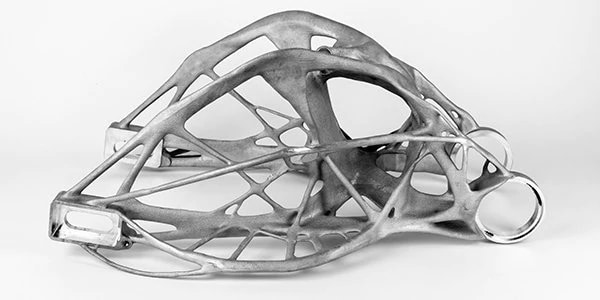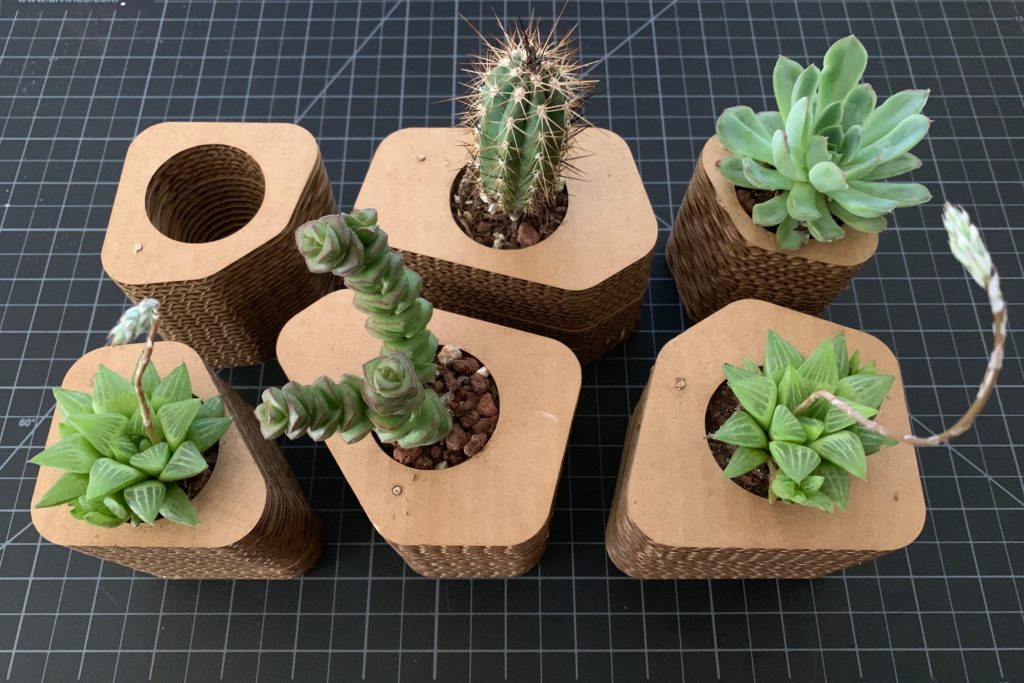Materials
The first step in my upcycle project was picking out what materials I would use. After looking around my house, I gathered some cardboard, plywood sheets, twine and a couple of mason jars. After looking at past upcyclying projects for the class I decided that I did not want to use wine or beer bottles since it seemed like they were a popular choice for this project and I want to create something different. Although I was able to gather all these different materials, I was going to need more of them. I decided to use cardboard and mason jars as the materials I would be working with since they are relatively easy to find.
Inspiration

After writing a blog post on organic design, I knew hat I wanted to apply that aesthetic to my project in some way. The fluid lines and inspiration from nature really draw my eyes to that aesthetic. Someone also suggested in my blog post that I look into generative design since it has some connections to organic design. After researching generative design, I was more drawn to the patterns that are created by these algorithms rather than the form itself. They look very natural and this is exactly the inspiration I needed. This aesthetic did not manifest into my first couple iterations but came back in the end to influence my final piece.

The last piece of inspiration that I looked to was patterns found in nature. I find fascinating the complex patterns that are found in nature. In some patterns specifically, there seems to be a natural order in randomness and it’s beautiful. The only problem is I had no idea how to replicate these patterns in CAD software. Exploring all of these various natural aesthetics, I realized that I had no living plants in my room or house. This is when I decided I wanted to make a set of planters.

Process
Before I could start making anything, I knew I had to collect more cardboard. I stumbled across the shelves of book boxes outside the UMC one day and began bringing back a couple of boxes everyday. At home, I would break them down into two useful pieces. My next step was to start brainstorming. I knew almost from the start that I wanted to apply the tools I was learning in my classes to the projects in this class. Luckily, I’m in a form class learning how to use Rhinoceros which is a very powerful software for organic design. I began putting down ideas in my sketchbook. After I had some initial sketches, I started transferring them over to Rhino to explore them some more. At this point, my experience with Rhino was very minimal but I was able to create some shapes which I liked.

After my design was complete, I had to open the files in a slicer program in order to laser cut the cardboard. Each iteration took about nine pieces of cardboard and around forty minutes to an hour to laser cut.
Iterations
I had my first planter made and I was pleased with how it turned out until we had a lecture on how humans are more drawn to curved/smooth objects, while sharp objects incite fear. I had to go back to the drawing board since I wanted my final piece to be an accent piece rather than draw a lot of attention.

My second iteration was based of a honeycomb structure but with very rounded edges. However, a quick google search showed me that I was the one millionth person to think of this idea. OOPS. This is also when I realized that if I wanted to make a lot of these to fit together I would need an absurd amount of cardboard. At this point, I discarded my original idea of incorporating a mason jar into the design since it was too big and restricting the shapes I could use.

I was back to the drawing board, but at the same time I was exploring the visual scripting plugin for Rhino called Grasshopper. I stumbled across a mathematical pattern called voronoi and this is exactly what I needed for my project. I drew a very rough sketch of what I wanted to do with this and dove directly back into the program.
Final

I was very pleased with how the final piece turned out. I was very frustrated at certain points of my design process but I just needed to keep working it through. My final piece was a set of six planters that were created with a voronoi diagram. I think that it pulls some aspect of all the the aesthetics I was exploring for my inspiration. Although I am done with project for this class, my next step is to create some 3D printed molds which I can make pour some concrete planters.
Presentation: http://youtube.com
References:
- https://www.autodesk.com/solutions/generative-design
- https://www.smithsonianmag.com/science-nature/science-behind-natures-patterns-180959033/
- http://www.museiitaliani.org/organic-design/


12 Comments. Leave new
[…] Upcycle Final […]
Hey Andre I was really impressed with your presentation. Your ability to use Rhino in the upcycled project is awesome and it creates a very interesting aesthetic with basic materials. I’m especially impressed with the aesthetic you created with the cardboard and the geometrical aesthetic created. This is a great indoor functional project however I think you could’ve increased the overall size to make it a bigger pot for indoor plants. Great project!
I never thought that recycled cardboard could come out looking so clean for these designs and the way your presentation went flowed very well.
Wow! This looked so professional! I love how you went through several iterations of the project until you had one you actually liked. I also love how you kept it with the cardboard look, the contrast of the green on the succulents to the brown is beautiful. I am just worried about what will happen to the cardboard when you water the succulents.
Andre great work! One of the best things is that nothing was bought, everything is upcycled! Interesting how you described generative design I didn’t know this term and I find it really interesting, I previously knew this form of design as topology optimization. Really like that you took this t the next level and used Rhino as it is a “higher level” CAD software. The Voronoi Pattern inspiration was very interesting, and your implementation was on point.
This turned out really well! I think succulents were the perfect fit for this because they don’t need much water and they look good with the cardboard. I know you talked about making the planters more durable with cement/paper mache, but do you have any intention of actually making it more durable in the future?
Yes! I’m in the process right now of making some 3D printed molds that I can pour the concrete into.
Hey nice work trying a new software and working with it. I am really interested in the aesthetics of simulation and I am curious if this Rhino would be something I could use in the future. Loved the explanation of how you iterated through to find something natural and novel.
Andre, I really enjoyed your presentation. I liked that you were focused on the mathematical shapes which I really enjoy. I also enjoyed that you used the laser cutter and Rhino which I do really want to learn to use. I was wondering if you would maybe consider using different mathematical patterns to create different designs. I was thinking that fibonacci sequence, especially since the succulents often grow like that. Overall I really liked your project!
I loved the description of your process, how you went through your iterations and why you chose to scrap certain versions and moved onto different designs. Your final product turned out great! I think the set works well, and the different shapes highlights your aesthetic. On a presentation note, you could’ve been more brief during the first half (inspiration, material, etc.), since the most interesting portion was the second half.
Nice work Andre. I really like the organic approach to your project from the very beginning. From the minimal experience that I have, this organic approach is the most difficult to make look visually pleasing. I am definitely interested in your overall process. You definitely could have stopped with your initial iteration and I really appreciated the continued effort. It was a great choice. Great and creative use of Rhino!
Hi,
I really liked how you are inspired by nature to design you cardboard. The end results looks very good. Have you thought about coloring the cardboard.